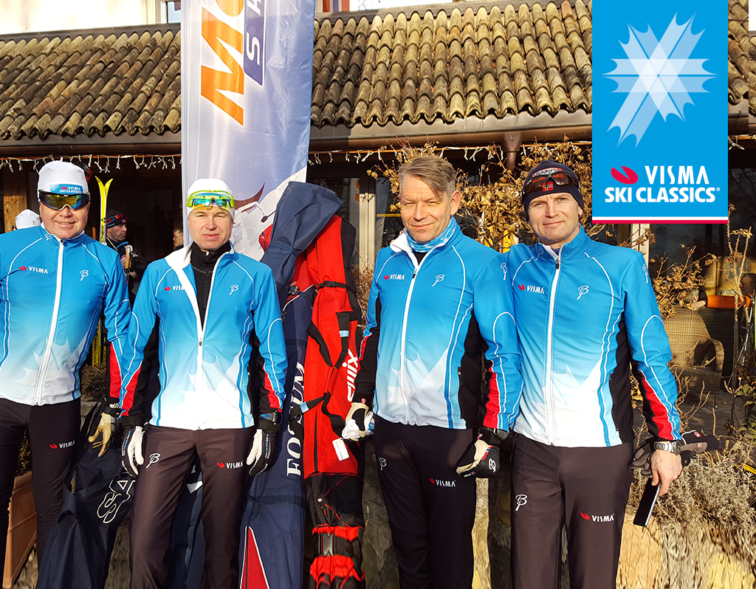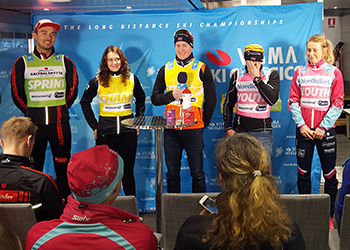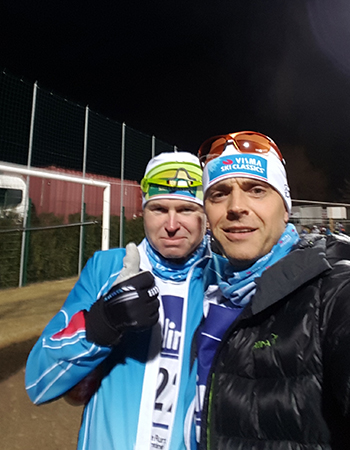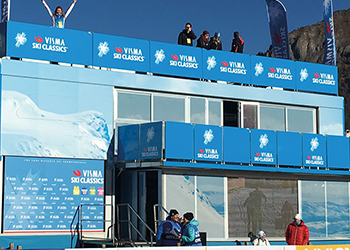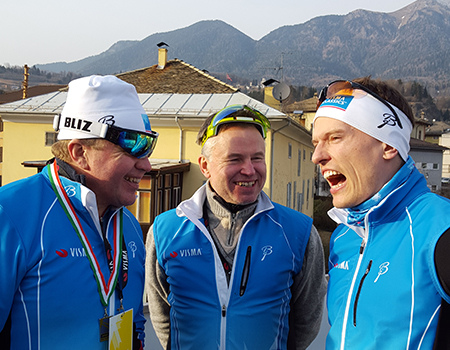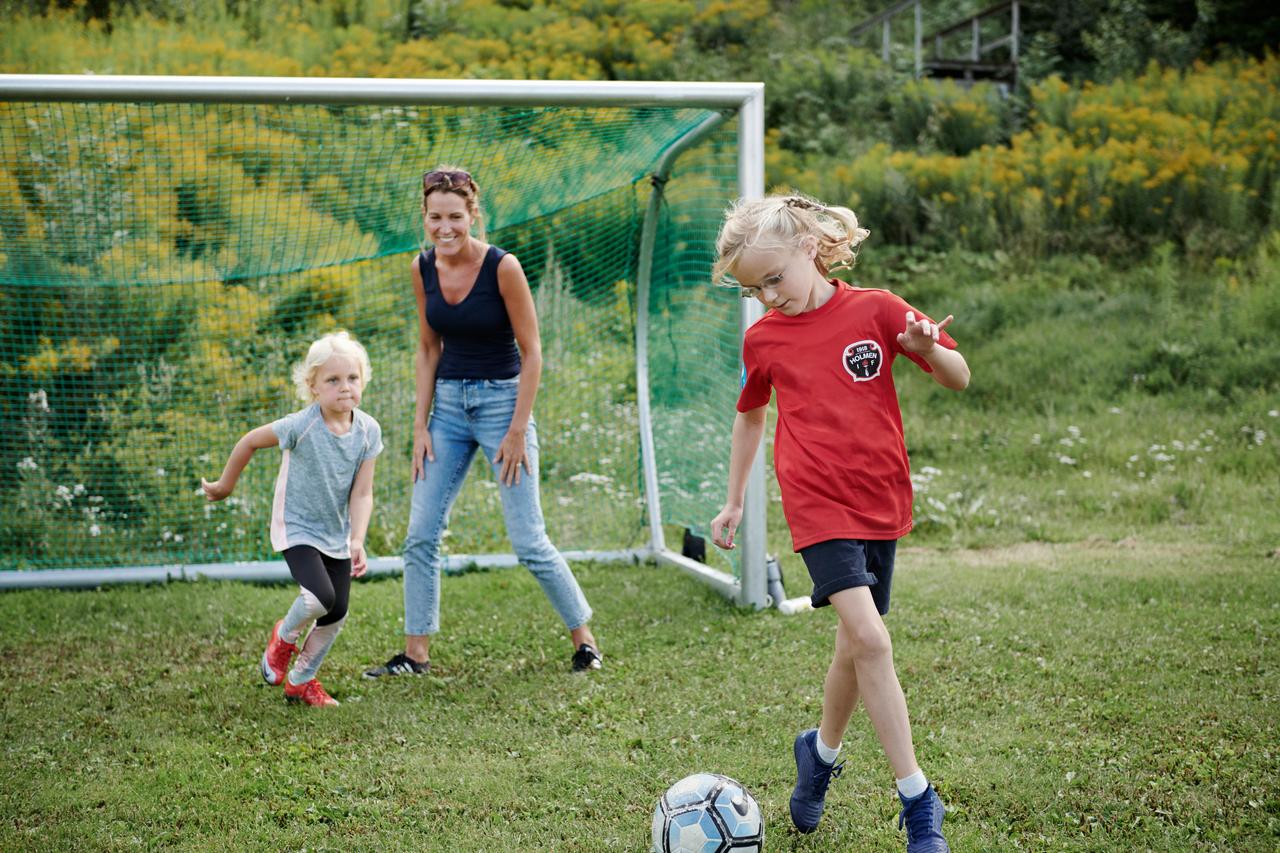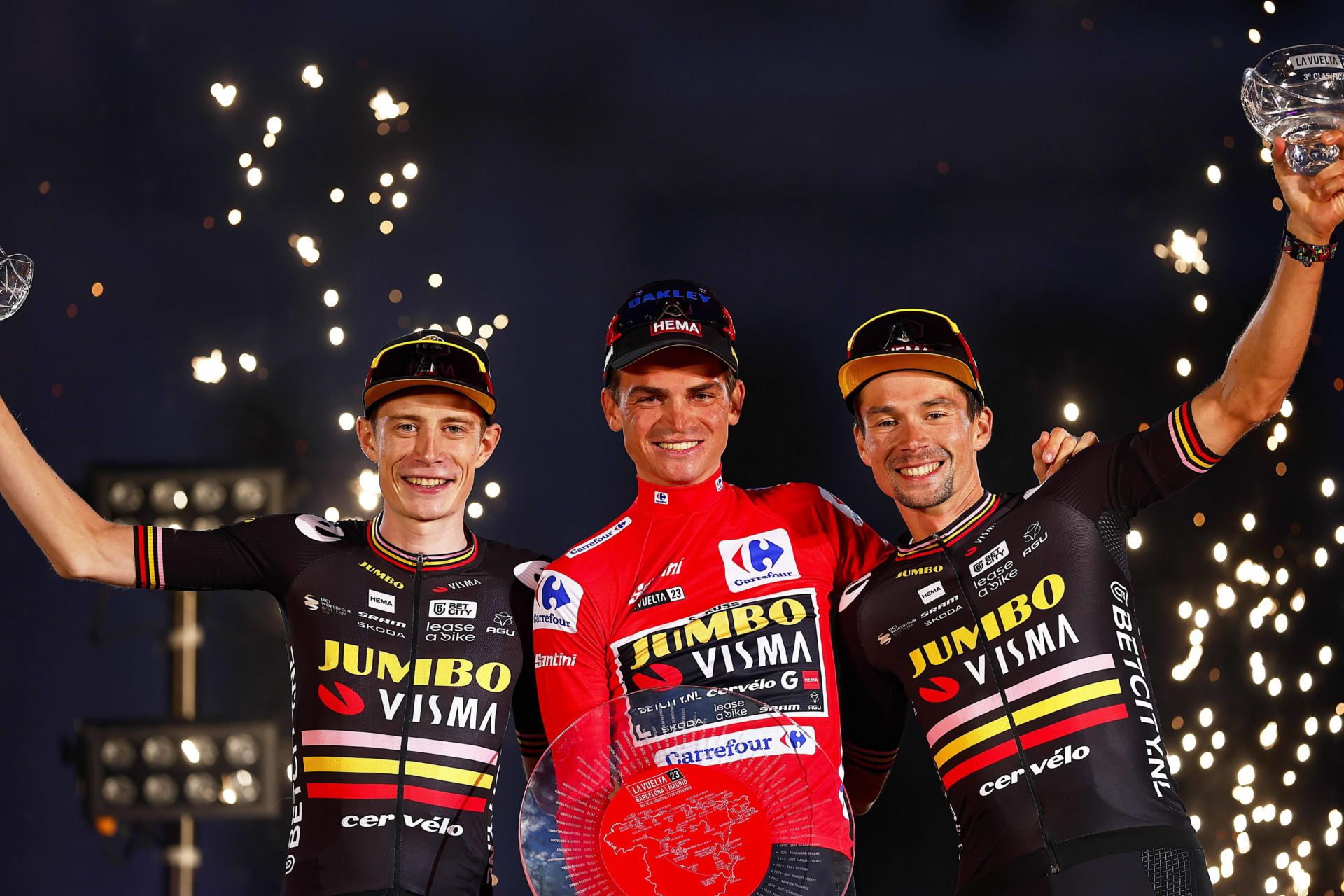This was a great opportunity to profile Visma and to meet Visma Ski Classics’ management, as well as employees, customers and skiers– and to participate in the great festival.
Visma’s delegation was: Chairman Gunnar Bjørkavåg, an old navy hunter and a sly fox on the ski trails. Gunnar was the only one who had skied Marcialonga before.
CEO Øystein Moan: Marcialonga was his first ski race. Ever. He practiced up in the heights of Hemsedal and skied evening sessions with a head light in a valley located in the northwestern part of Oslo. He also had a “white month” in order to prepare himself as much as possible for the race.
Division Director Roar Wiik Andreassen: Also made his ski race debut. Prepared himself with several ski trips outside of Oslo.
Division Director Eivind Gundersen: Experienced with ski races, but he had never run Marcialonga before. He was well-prepared with several poling trips outside of Oslo and around his cabin at Sjusjøen. A damaged ankle contributed to extra poling practice.
Managing Director at Visma IT & and Communications: Espen Håkonsen, also made his ski race debut. He prepared by doing daily double poling sessions in his basement using a newly-purchased poling machine. Highly focused and dedicated to the task ahead of us.
A group high in expectations and excitement left Oslo on Friday. There were many questions before the race and the discussions on glide wax, wax and ski base structure were lively. Espen spent several hours in the wax room days ahead of time, and had laid the legendary Guruputa with the assistance of a variety of YouTube videos. Was it too thick? Was it laid properly? Had it hardened enough? Espen wondered this a lot on both Friday and Saturday. After being inspected by several experienced waxers, Espen received the confirmation he needed to get a good night’s sleep.
The founder of Marcialonga
There was a calm dinner at the hotel following our Friday evening arrival. We sat for a long time and spoke with Franco Nones, who founded the Marcialonga 43 years ago. Among other achievements, he won the gold medal for 30 km cross-country at the Olympics in Grenoble, and he had many exciting stories to tell. His birthday was around the same period, and the violinist Arve Tellefsen, who was also participating in the race, held a wonderful mini-concert in his honour.
Final race preparations
On Saturday morning, we went to the ski stadium at Val di Fiemme to test our skis and to get a feel for the trails. Øystein tested two pairs of skis and concluded that his old ones still reigned supreme, choosing them over his brand new skis. I tested my skis versus those of Team Exspirit and Daniel Richardsson. The results put me at ease. Roar said the trail didn’t seem as tough as he had feared. He’d be eating his words the next day. Those who needed to wax their skis handed them in at the hotel, and they got their finished skis back the same evening.
We went to Cavalese and the finish line area after this, where the Visma Ski Classics trailer was located. Meetings with business partners were being held here, and the marketing director of the Fischer group held lectures. Team LeasePlan Go’s Team Manager Emil Weberg Gundersen and the skiers Stian Hoelgaard and Petter Eliassen inspired us by telling us about the race, and about the tactics they had prepared for the coming Sunday. This was followed by a procession of teams, associated team leaders and skiers, as well as sponsors. We had an early dinner after this busy day and went to bed at a reasonable hour.
Ready, set, gooooooo
On the day of the race we had breakfast at 05:00 AM. Everyone slept poorly, with frequent bathroom visits. Our bodies were uneasy, subconsciously preparing us for the intense exertion ahead.
We started in different groups. Øystein and I started in the field behind the elites. That’s the group where the tension is at its peak and the madness reaches its greatest depths. I’m familiar with that madness, but Øystein also thought it was fun to get a look at how this strange dynamic played out. The entire starting booth had a blissful aroma of tiger balm, beet juice and urine. When the shot was fired and the gates opened, the chaos was absolute. Some were ploughed down and poles broke. Adult men with good educations and high-paying jobs howled and screamed. They chased forward as though the run was a 100 metre sprint, not a 70 km run. More than a civilised ski race, it resembled a jailbreak.
I had decided to double pole the entire race and chose to proceed without wax. The trails were hard, firm and nice for the first few tens of kilometres moving up the hilly valley, before we turned and sped down the other side of the river. The trail passed through small villages, over bridges and through tunnels. It even cut through a warehouse. A festival was taking place in the villages, creating a fantastic atmosphere. Down through the valley we passed through slightly rolling terrain with a few bends. After a while, the sun started to catch up and the trail grew wet and loose, and my skis began to drag. When there’s only 8 km left of the trail, it turns and you get a slow, 5 km incline before the monstrous 3 km hill leading up to the finish line at Cavalese. I had decided to stop at the bottom of the hill to apply wax in order to do a diagonal stride up the final 3 km. Reaching the bottom of the hill I concluded that since I had already poled 67 km, I might as well pole the rest of it. It wasn’t fast, but it was still fun to have poled all the way up. My goal was to complete the run in less than 4 hours. My score was 3:50, which satisfied me on my smooth skis and the difficult conditions.
Although all of us at Visma skied the same race, it was different for all of us. Differing basic conditions, techniques, equipment and ambitions led to decisively different experiences. My experience completing the ski race at Marcialonga was thus different from my colleagues. Here is some insight into their skiing experiences:
Øystein – generous with the grip wax
Many pushed forward to stand at the very front to be the very first. Seeing as I didn’t have any ambitions beyond survival, I calmly positioned myself at the back with some Italian and Swedish pensioners. I calmly set off after the madmen had stormed ahead, fumbled a little with my poles and got going more or less at the back of our group. After a few metres, the inspiration that comes with wearing a race bib materialised and I started to ski faster than I
should have, so that I could catch up with the pensioners. The first downhill slope was utter chaos; nervous and a little inexperienced skiers had stopped completely, and I couldn’t slow down. I ended up crashing into an Italian man, who I grabbed around the waist, pushing him off to the side. I was able to stay on my feet, but not everybody else did. It was nice not knowing any Italian.
As I was worried my skis would be too slippery, I was a little generous with the grip wax. This worked excellently uphill, but basically everyone poled past me on the flats. Terribly frustrating, but I tried to take it as a pleasant Sunday trip. I spent plenty of time at the drinking stations, ate prunes and raisins and studied the people. A great atmosphere, a bit like the 17th of May. When they’re cheering one person on, the Italians say “bravo”. When they’re cheering everyone on, they say “bravi”. I got a lot of bravo and sympathetic looks. After 20 km I was starting to get pretty exhausted, but fortunately I had been prescient enough to sign up for Marcialonga light, which means that you reach the finish line after 45 km, not 70 km. When I reached the 45 km finish line after 3:58 hours, I had skied more than far enough, and I was very happy with my decision. I went to the goal area in a fairly good condition, completed my “white” January and went to receive the 70 km skiers.
I’ll be back next year, but with better training and a little less grip wax. Maybe I’ll take the 70 km then.
Roar – tears in my eyes
I was probably a little cocky on Saturday, with its firm tracks and good grip. I felt the warmer conditions up close after a while, and it became a long day of work in the traditional classic style.
As a brand new ski racer I have learned a few fundamentals. First; three weeks of preparation isn’t quite enough after you’ve fractured a rib and ski under poor conditions in the lowlands. And as my son says, “your poling technique stinks, dad”. No matter how well you can do the classic style, you can’t compete with skiers who use a good poling technique.
The first part of the race, about 20 km, went fairly well going forward, and I set out pretty hard. I had seen the elites on the way down, running hockey or light poling postures at lightning speed, and I was really looking forward to forging ahead with a smooth glide for 50 km. I got a nice surprise when my skis practically stuck to the slush at the top of the trail. At that moment I thought to myself that this would be a long way home. Fortunately, there was a great atmosphere along the trail. Good food and drink was had on the way, and I passed through many lovely villages. When I finally saw the 3 km hill, it felt good to smear on some asphalt and climb up. Poling definitely wasn’t an option. I got tears in my eyes when I saw the Visma Ski Classics trailer.
The finish line area and after ski serving at the trailer felt good. The atmosphere and framework surrounding the event was just fantastic, and it left me feeling good. So if I were to do another run; I would need to purchase and vigorously use a poling machine, buy roller skis, go without wax on my skis, and it would maybe be nice to get some snow a little earlier next year. That would help my time, and maybe soothe some of the pain in the variety of tiny muscles I didn’t even know I had.
Espen – raisins under my skis
I signed up for this ski adventure just two months ahead of the race. Before that, I hadn’t gone skiing for nearly 20 years. That was on my World Championship skis from 1982, using poles that were the first to be invented after bamboo.
I had a wonderful learning curve using YouTube as my primary source for technique and equipment requirements, not to mention for ski prep and waxing. Early on it became clear that double poling is the big thing, and getting a hold of a wall-mounted poling machine was essential. Evening after evening in the garage, heavier and heavier sessions, striving to get in shape as best as possible and to be as prepared as possible for the 70 kilometres of Marcialonga. With 250 km of ski technique training, and skis that I spent half of the last night “gliding” and waxing on my own, I arrived at Val di Fiemme. At that point I’m only nervous that I’ve waxed my skis wrong and that the downhill slopes are too steep. During the evening I get the confirmation that my wax is all good.
On the day of the competition the butterflies in my stomach fluttered with no end in sight. With a 250 metre bathroom queue and only 20 minutes to start, my only option is to run to the starting area. The shot rings out and I forge ahead with my head up and forward. I immediately try to summon up all the advice I’ve received the past few months. “Don’t start too hard”, “enjoy the trip and look around”, “straighten up during your diagonal stride”, etc. etc. It works pretty well, for a while, although I barely even notice the sights and nature around me. This is a contest! After 25 kilometres, my elbows decide to rename themselves “golf elbows”, and the remaining 45 kilometres are completed on willpower alone. With a relatively low pulse I am slowly able to take in the nature and life around the trail. An unparalleled circus, and a wonderful atmosphere the whole way. It’s a little kick of adrenaline every time an Italian finds my name in the start list and calls out, “Brava Espen!”. I push a little harder when that happens, for the audience’s sake.
The biggest shock I had during the race was when my skis suddenly started to drag heavily, and I thought my home-waxed skis weren’t good enough. I sighed with relief when I checked them and saw that raisins from the previous food station had gotten stuck to the grip wax. It’s an incredible feeling reaching the finish line after 70 km, and I had specifically practiced stretching my leg to step over the finish line (but I chose not to do it, since my final time was close to eight hours). Next year, I will go for a personal record.
We were warmly received at the Visma Ski Classics trailer after the race, meeting at its strategic location by the finish line area. The Visma Ski Classics group was waiting for us there, with kind words and plenty of good food and drink. A cold beer in the sun has rarely tasted so good. Gradually the trailer began to fill with Visma employees and other guests, specially invited for the after-ski party. The atmosphere was great and most were very satisfied with the day itself, even as the conditions outside worsened. That evening we were invited to a very pleasant dinner with Marcialonga and Visma Ski Classics management. We had a fairly calm evening, as we would leave by bus for Munich at 06:00 AM on Monday morning.
A fantastic trip
This was a fantastic trip. It was a great opportunity to profile Visma, meet the Visma Ski Classics management, as well as employees, customers and skiers, and to take part in this great ski festival. We experienced Visma Ski Classics up close and got to know the contents of our sponsorship. Many passionate people were doing great work for both Visma Ski Classics and Marcialonga. Visma comes across well and is highly visible in all our profiling. A lot of people came over unprompted to ask where we bought our Visma Ski Classics ski suits.
Feedback was uniformly excellent from customers and business partners from both Norway and the rest of the Nordic countries.
Marcialonga is highly important to the entire valley, and it was important to complete the event even without a single gram of natural snow. Since the snow stayed absent this year, it has been a major collective effort to produce 70 kilometres of artificial snow. All credit goes to the event management for pulling this off.
We all also agreed that this wouldn’t be the last time we participate. We’ll probably all be back again next year. Some of us have even promised to practice a little more for an even better experience.

